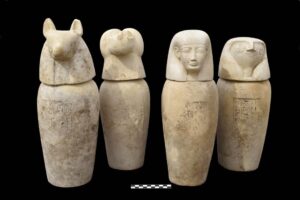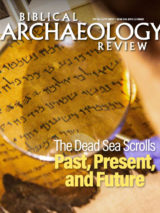Revealing the Mortuary Temple of Ramesses II
New discoveries at the Ramesseum in Thebes

Canopic jars discovered in the area of the Ramesseum. Courtesy Egypt’s Ministry of Tourism and Antiquities.
A joint Egyptian-French expedition made an incredible discovery while carrying out excavations and restoration work at the mortuary temple of Ramesses II, the pharaoh often associated with the Exodus. The excavations revealed several new areas of the massive temple complex and numerous tombs dating to a few centuries after the temple’s original construction.

FREE ebook: Ancient Israel in Egypt and the Exodus.
Commemorating the Great Pharaoh
The mortuary temple, known as the Ramesseum or the “Temple of Millions of Years,” was one of the grandest construction projects carried out by Ramesses II (r. 1279–1213 BCE), one of the greatest pharaohs to ever reign over Egypt. Located in the Theban necropolis across the Nile from the modern city of Luxor, the temple served as a place of commemoration and worship of the pharaoh, both before and after his death. Today, the temple is recognized as part of a UNESCO World Heritage Site.
While carrying out excavations inside the temple, the Egyptian-French team uncovered the “House of Life,” an ancient scientific school that was attached to most major temples. Inside, they discovered the remains of drawings and school games. The team also identified administrative buildings, workshops, and cellars to the east of the temple. The workshops included kitchens, bakeries, and areas for stonework and textile production. The cellars served as storage for olive oil, honey, wine, and more. According to a press release by Egypt’s Ministry of Tourism and Antiquities, the various buildings indicate that the temple featured a complex administrative apparatus and served as both a place of worship and a local distribution center for manufactured goods.

Ushabti figurines discovered in the area of the Ramesseum. Courtesy Egypt’s Ministry of Tourism and Antiquities.
Excavations to the northeast of the temple also revealed many tombs dating to the Third Intermediate Period (c. 1070–664 BCE). Most of these were shaft tombs that contained well-preserved canopic jars, funerary tools, coffins, and ushabti figurines.
The Egyptian-French expedition has been working at the mortuary temple since 1991 and has systematically carried out excavations and restoration work. Although one of the grandest construction projects of Ramesses the Great, the temple suffered more damage through history than some of Ramesses’s other construction projects, such as the famous temple at Abu Simbel. This may be because the location of the mortuary temple near the Nile’s floodplain damaged its foundations, leading to large areas of collapse.
Become a BAS All-Access Member Now!
Read Biblical Archaeology Review online, explore 50 years of BAR, watch videos, attend talks, and more

Related reading in Bible History Daily
All-Access members, read more in the BAS Library
BAR Jr.: Gamma Rays Halt Deterioration of Mummy of Ramesses II
Not a BAS Library or All-Access Member yet? Join today.
Must-Read Free eBooks
Want more Bible history?
Sign up to receive our email newsletter and never miss an update.
Unlock Unlimited Access to the Bible's Past
Become an All-Access Member to explore the Bible's rich history. Get Biblical Archaeology Review in print, full online access, and FREE online talks. Plus, enjoy special Travel/Study discounts. Don't miss out—begin your journey today!











